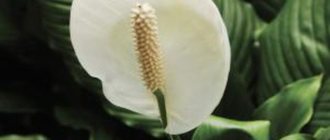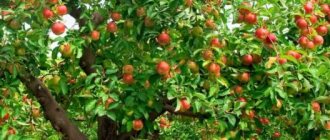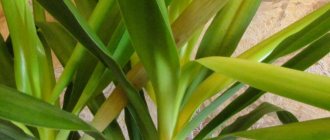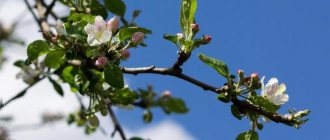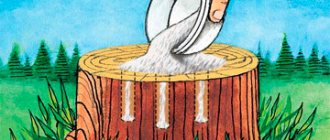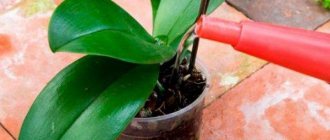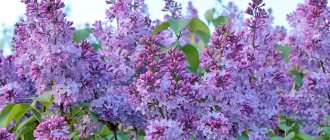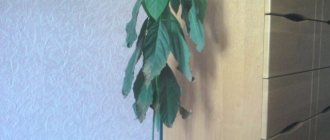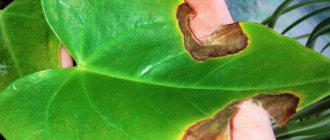Owners of a garden plot with apple trees are wondering how to increase productivity. For this purpose, various fertilizers are applied to the soil, and regular watering is carried out according to the established schedule. However, it is worth carefully monitoring the condition of the plants themselves. The most common case is problems with tree trunks. As a rule, this is due to various factors. Therefore, the question quite naturally arises of how to save an apple tree with a damaged trunk. To understand what needs to be done, you should know the description of a number of diseases and how they manifest themselves.
The harmful effects of diseases on tree bark
The bark covering the tree trunk is its protective shell. This is the first step in protecting the plant from external influences. Violation of integrity leads to weakening of the plant, which reduces flowering and, accordingly, the harvest will be less.
How can you restore the bark of an apple tree?
Note! If you do not save an infected tree, it will die within a season or two. Along the way, it can infect surrounding trees, which can turn into an entire epidemic throughout the garden.
What to do if the trunk of a young apple tree is cracked?
Cracked apple tree trunk: photo
If the trunk of an apple tree (of a young tree) is cracked, in this situation you should act according to the scheme we have already discussed. Obviously, your first step is to connect the wound together using a clamp or even suitable water pipes. If, even after an incredibly diligent connection, a small gap remains on the tree, then there is no need to worry about this.
However, only under the condition that the width of the “scar” does not exceed:
- 0.5 cm for an apple tree whose age is not more than 13 years;
- 2 cm for an apple tree whose age is less than 13 years.
If you're still plagued by the problem of not having a partner to help you compress the wound, don't worry about it. It is enough every day to tighten the connection a little more and more. Gradually the wood will become more and more pliable, and eventually you will be able to connect both halves of the split quite tightly.
If you use this squeezing method, you can resort to gradually pouring wax into the gap. This will improve healing, but be aware that the wax should never get on the bark! One way or another, sooner or later he will be squeezed out. However, fresh wax should not end up on the bark.
If the crack on the apple tree is not too big, you don’t even have to worry, because, rest assured, it will heal soon. And then your apple tree will be healthy again. To speed up healing, you can use var or drugs such as chlorohexogen.
Applying small longitudinal cuts on the bark stains will help the apple tree take on an aesthetic appearance more quickly. With their help, the bark along the edges of the “scar” will heal much more readily.
Nature of the wound
How to graft an apple tree in summer and budding other fruit trees
In order to choose the right solution to get rid of the cause that caused damage to the tree bark, you first need to understand its nature. Two groups can be distinguished here:
- mechanical damage;
- infectious lesion.
Treatment methods are different in each case, so it is necessary to carefully determine the nature of the disease. This is the only way to increase the effectiveness of therapy.
In addition, any injury, and especially a severely open one, is regarded as an entry point for various infectious pathogens and pests. How this can end is already known, so it is necessary not only to feed and water the trees, it is important to pay attention to changes in the bark.
Signs and properties: why apple tree bark can crack
The disease becomes noticeable during flowering or later, in early summer.
- First of all, the bark changes - characteristic tubercles appear on it, the so-called “goose bumps”, inside of which spores mature (fungi and larvae remain). However, in reality this sign is hardly noticeable.
- During flowering, flowers on one or several branches dry out (dry) and do not fall off for a long time, and may rust.
- The damaged bark changes color - it becomes red-brown/red/orange and even green, and swellings appear on it. The spots quickly grow and encircle the branch. Gardeners call this moment the “interception phenomenon.” At the same time, the bark practically does not allow juice to pass through, it can foam and the branch begins to die and peel off, move away, and finally move away.
- Leaves, bark, and flowers around the damaged area dry out. The bark darkens, becomes covered with ulcers, begins to peel and dies. In advanced cases, the fungus (fungus) also damages the wood. Deep cracks appear at the boundaries with healthy bark and gum is released.
- When intercepted, a thin branch dries out and dies, and does not recover after treatment (it is impossible to remove the reason why it is bursting; it is no longer possible to help). The skeletal branch and trunk can be restored.
Cytosporosis is quite easily confused with black cancer. However, with the latter, a small fungus tends to appear and is located in clear concentric circles, and not in the form of chaotically located tubercles. In addition, with cytosporosis, the bark becomes spongy and does not flake off (do not become detached from the base, peeling even on old snags).
The disease is difficult to treat, so it is much easier and more effective to carry out prevention than to treat an infected garden later, when it can no longer be treated, there is no point.
Mechanical damage
Is it possible to graft a pear onto an apple tree - features and timing of the procedure
Apple tree trunks can receive such wounds as a result of rodent attacks or natural disasters (strong gusts of wind, hail, exposure to high and low temperatures). Improper formation of the tree crown also leads to damage to the bark.
But the cortex does not always suffer due to direct physical impact. In some cases there are natural reasons for this. The old “skin” becomes cracked and peels off, and a renewed coating appears in its place. This process does not require human participation, although it will take some time.
Non-infectious wound
Rodents
This can be recognized by the frayed bark near the surface of the earth. If only the top layer of bark is damaged, this indicates mouse bites; hares leave deeper marks.
To protect trees, a special structure is made that resembles a cap. Usually corn, reeds, and branches of coniferous plants are used. They tightly wrap the tree trunk, as well as the branches of the lower tier. In the spring, the covers need to be removed.
Break of a large branch
You should know how to save an apple tree if it is broken by the wind and the trunk splits. In this case, the tree receives an extensive wound and it is difficult for it to recover on its own.
Important! Any wound should absolutely not be treated with tar, kerosene and other petroleum products.
You need to act immediately and first a disinfection procedure is necessary. Afterwards, the wound should be treated with first aid products for plants (garden pitch, oil paint based on drying oil, Bugorkov's balm). Additionally, the wound can be lubricated with a prepared mixture of “Kornevin”, “Immunocytophyte”, and BF-6 glue.
Cooking method:
- To begin, mix three ingredients together - “Kornevin”, “Fundazol”, wood ash.
- Add crushed Immunocytophyte tablet.
- Add BF-6 glue. The mixture should have the consistency of thick sour cream.
The wound is covered with this ointment, and you need to slightly capture part of the healthy bark. The composition is not suitable for long-term storage.
Agrotechnical techniques
Sometimes the gardener himself can harm the hearth trees. The tree tries to heal the wounds on its own in a short time. At the same time, it is better to be careful when performing various operations so as not to damage the branches or trunk. There is no need to rush during pruning and crown formation.
Burn and frostbite
Exposure to temperature changes also negatively affects the condition of tree bark. Sunburn (between April and May) is usually indicated by the peeling of the bark in large pieces. The branches themselves take on a pinkish tint and look burnt.
Evidence of sunburn on an apple tree trunk
Preparing garden varnish to putty damage
Garden varnish is used to treat wounds on apple trees and other fruit trees. They can also be used to treat fusion sites during vaccinations. The putty is an environmentally friendly product. You can buy it ready-made or prepare it yourself. There are many ways to prepare the brew. Experienced gardeners recommend using Zhukovsky or Pashkevich var. The first putty contains 3 components: wax, rosin, lamb fat. Most often, all components are taken in the same quantity, but wax can be taken twice as much.
Wax closes cracks and protects them from moisture and pathogenic flora. Due to the fat, the composition on the trunk does not crack. Rosin gives the composition stickiness so that it adheres tightly to the bark. To prepare, melt all components in separate containers over low heat or a steam bath. While they are hot, mix together and pour into cold water. The mixture does not sink, but floats on its surface. The putty is collected from the water and rolled into a ball. It kneads very easily and has a consistency similar to plasticine. The putty is stored in a dark place, wrapped in oiled paper. During storage, the varnish hardens slightly; before use, it is heated until soft.
The composition of Pashkevich's var includes 4 components:
- rosin - 2 parts;
- yellow wax – 4 parts;
- turpentine – 4 parts;
- rendered fat - 1 part.
First, melt the wax, then add rosin and turpentine, mix until smooth. Lastly, melted fat is added. The composition is poured into a container with cold water and collected into one lump. Stored like Zhukovsky's var. Before using garden varnish, the damaged area is cleaned and can be additionally treated with copper sulfate. After applying the mixture, the section of the trunk is wrapped with natural fabric.
Important!
Instead of garden varnish, you can treat the trunk with biobalms, which are sold in specialized stores; instructions for use are indicated on the packaging.
How to treat an apple tree for bark damage
How to grow an apple tree from a seed at home
The problem can be prevented by whitewashing. It is optimal to use special garden solutions or water-based paint.
Important! Whitewashing of trees should be carried out in late March-early April. That is, it is worth thinking about protecting trees before the leaves appear.
Deep cracks indicate the effects of low temperature, although the color of the inside of the shoot does not change. In this case, no outside intervention is required; the tree also copes on its own. During the period of sap flow, the cracks are filled with secreted liquid, due to which natural healing occurs. It is better not to interfere with this process; it is better to treat wounds after they are completely filled with wood adhesive mass.
Restoration of the cortex after mechanical stress
It all depends on the degree of damage. Broken branches are cut to the base, after which the sections are smeared with garden broth. It also treats small cracks, although the tree itself will heal them.
Major damage requires human intervention. To begin with, the affected areas must first be thoroughly cleaned, especially when pests have settled there. Next, you need to disinfect with a weak solution of copper sulfate or another product containing copper.
To stimulate healing, wound areas should be covered with a mixture of yellow clay and mullein (1:1). It is permissible to use pure clay, which must be softened in advance.
Usually such measures are enough to avoid serious consequences from the wounds caused. Trees have a good ability to regenerate and in most cases they will recover on their own within a season.
Frostbite or burns
Dead areas of bark are formed as a result of frostbite or sunburn. In areas of sunburn (April–May), the bark looks a little lighter with wide layers of exfoliation .
Sunburn is prevented by timely whitewashing .
Sunburn of the trunk.
The bark of an apple tree with deep cracks in the trunk, without discoloration, is the main sign of frostbite. The tree heals frost wounds on its own; when sap begins to flow, the cracks are healed by the secreted sap, so it is not worth treating such damage with garden varnish; it is better to carry out disinfection after filling the cracks with wood “glue” - clean out the unevenness, lubricate it with Ranet.
Methods of prevention: for the winter, we wrap the main trunk and skeletal branches of apple trees with ribbons made of natural fabrics (burlap, denim, thick cotton), carefully securing them. This product will not protect you from severe frosts, but it will be effective during sudden daily temperature changes.
Frost wound.
Important! A mistake gardeners make is applying whitewash in May. It is important for the tree to receive protection before the leaves appear during increasing sun activity, which is typical in late March - early April.
Infectious diseases
If a tree is attacked by pathogens, the consequences can be quite serious. Therefore, you should study in advance how to restore the bark on an apple tree in this case. Otherwise, you can forget about the harvest.
Cracks in the bark should be a concern for any gardener.
Often the bark of trees is affected by fungi or bacteria. If the affected tree is not treated, the infection will lead to its death and then spread throughout the garden.
Black cancer
This is a fungal disease caused by the pathogen Botryosphaeria. In countries with a temperate climate there is a high risk of contracting such an infection. The diet of the fungus includes not only living but also dying tissues.
Additional Information! Many experienced gardeners call this disease "Anton's fire" or "holy fire", which is a reference to the story of St. Anthony.
The rate of spread is high, which leads to rapid infection and death of the entire garden. Botrispheria settles not only on apple trees - almost all fruit crops are under threat.
At the initial stage of fungal infection, the bark becomes covered with cracks with brownish dots. Subsequently, they become spots that deepen, expand and become covered with a black coating (as if the wood is charred). The branches appear scorched, and the leaves darken, dry out and curl. The final stage of the disease is accompanied by the formation of black rings and this means that the tree has died.
European cancer
It is also called ordinary and, unlike its black counterpart, develops more slowly. The causative agent is the fungus Nectria galligena, which hides in the bark of a tree for the winter, and becomes active in the spring. Infection can occur due to damage to the bark (even the slightest), improper pruning of branches or grafting of trees.
The disease itself occurs in open or closed form. In the first case, deep damage is formed that reaches the core of the wood. Their contours externally look like tumors. When infected with a closed fungus, small growths form on the bark, which hide the wound. They subsequently die, exposing the wood. The spores remaining for the winter form a thickening, where a whole colony of the fungus is formed. Its elimination leaves a cavity in the tree.
Bacterial cancer
Another very dangerous disease caused by gram-negative rods. It is usually introduced by new seedlings that have not been properly treated. The affected area is covered quickly and it is extremely difficult to cure such a pathology. It is necessary to begin therapy at the slightest sign, otherwise the disease will completely dry out the tree.
Bacterial canker on the trunk of an apple tree
Note! Sometimes applying a kind of patch from the bark of the same apple tree to the affected areas is effective in combating bacterial disease. It is only necessary to treat the entire tree trunk and crown with fungicides.
The symptom is the appearance of small green-brown spots, which later turn into soft blisters. Inside these blisters, the tissue begins to rot. If left untreated, a crust forms on top, and the fungus actively develops inside. As a result, the leaves begin to turn black and mummify, young branches dry out, and flowers wither.
Cytosporosis
The causative agent of this fungal disease belongs to the genus Cytospora. Its spores are able to penetrate into the deeper layers through cracks and small wounds. The development and spread of infection is rapid - the bark dries out in only one season without proper treatment. The fungus behaves extremely aggressively and affects both the bark and the wood itself.
Cytospora lesions appear as blackened ulcers framed by gray tubercles. As a result, the bark changes greatly, becoming spongy. The leaves, along with the ovaries on the branches with the fungus, dry out, and then curl and fall off. When the pathogen penetrates deeply into the wood, a crimson or reddish liquid begins to ooze from the cambium.
Apple tree trunk diseases and their treatment
Cytosporosis
Brown-red cankers , which initially appear only as slight darkening, and later cover large areas of the bark, deforming the surface and leading to the breaking off of dying branches. A fungal disease that leads to rapid, 1-2 seasons, death of the apple tree.
Reasons: weakening of the plant due to planting on depleted soils, non-compliance with the feeding and watering regime, the presence of mechanical damage.
Cytosporosis on an apple tree.
The sooner treatment is started, the greater the chance of saving the plant.
- We remove infected areas mechanically, removing damaged branches as much as possible;
- On large, slightly damaged trunks of apple trees, use a knife to cut off the damaged bark and part of the wood, leaving a healthy area of up to 1 cm;
- Treat with a solution of copper sulfate;
- Cover with a solution of mullein and clay. It is better to wrap such a rescue compress with a bandage and moisten it with an aqueous solution of heteroauxin (2 tablets per 10 l) or just water during the season.
To prevent the spread of the disease we use the following means:
- The drug "Hom" . Dissolve 40 g in 10 liters of water, spray until the buds swell;
- Copper sulfate. Before flowering, spray the apple tree with a solution of 50 g of the chemical in 10 liters of water;
- Tank mixture containing trichodermin . We process before flowering, with the solution evenly applied to the leaves and bark.
Black cancer, "Antonov fire"
Fungal disease. Trees weakened by heavy fruiting or growing on poor soils are more quickly affected. On strong and healthy apple trees, the fungus can develop unnoticed for about two years.
It is characterized by the appearance of brownish spots that degenerate into depressions with a black coating. In this case, the border between a healthy cortex and one damaged by the disease is clearly visible. The charred bark falls off with slight peeling, exposing the trunk. Wood damaged by cancer is tiny and loose. In 3-4 years, this disease can completely destroy a garden.
Black apple tree cancer.
The best remedy is to completely get rid of the diseased tree. We uproot in calm weather and burn the entire tree to avoid the spread of infection.
If the disease has affected nodes or small areas that are not vital remove the infected area and then treat the open wound:
- We treat the clean cut with copper sulfate, then apply putty and mullein and clay;
- Small areas after treatment with copper sulfate can be painted over with oil paint.
Advice! Since, in addition to the bark, black cancer can infect both leaves and fruits, it is advisable to completely treat the apple tree with Bordeaux mixture after flowering.
Common cancer
from black in growths and swellings, surrounded by dark red expressive tubercles. The rate of damage from common cancer is lower, and the chances of saving the tree are much greater.
Common apple canker.
It affects both young and old trees. The methods of fighting are the same as with black cancer. Areas of bark, wood, and leaves removed during processing are subject to mandatory burning. Tools that have come into contact with diseased trees will be disinfected with alcohol .
It is better to carry out preventive treatment for both types of cancer several times a season.
At the same time, we monitor the size of the affected areas. If treatment of the apple tree trunk turns out to be ineffective, it is better to part with one tree than to lose the orchard.
Fruit therapy course
Now about how to treat an apple tree if its trunk is damaged. Typically, many infectious diseases (including the examples listed above) use a general framework. Here it is even possible to draw a comparative parallel with the mechanism of treating wounds of mechanical origin. But depending on the causative agent of a particular infection, a number of additional operations are required.
How to treat the bark of an apple tree
In general, the algorithm is as follows:
- To begin with, the wounds are cleaned well.
- Next, you need to cut off the affected areas. You should capture 2-3 cm of tissue that is alive and untouched by the pathogen, as it can remain there.
- Now you can begin disinfection using antiseptic drugs (copper, iron sulfate, potassium permanganate). If the infection is of fungal origin, it should be treated with fungicidal preparations.
- After the disinfection procedure, the wound must be covered with clay, oil paint, or a garden decoction should be used for this purpose.
- Spray the entire infected tree with fungicide, including adjacent plants.
- All collected waste must be burned away from garden crops.
- Disinfect used tools.
Important! In case of severe infestation, it is optimal to completely remove it from the site. It’s better to make small sacrifices than to lose an entire garden later.
Infectious diseases are dangerous due to the high speed of spread and development of pathogens. Fungi are easily spread by water, wind, birds, and for wintering they choose soil for shelter.
Nuances and questions from readers
Plaque on the trunk
On an apple tree, a greenish coating on the trunk is formed by lichens and unicellular algae. Their appearance is due to thickening of the crown and lack of free air circulation.
It does not harm the tree, but when it accumulates in the axils of the branches, it promotes the reproduction of various insects under the cover. Clean with a spatula or a hard sponge.
How to treat the trunk of an apple tree if the bark is damaged?
For minor damage:
- Dead areas are cut out;
- Disinfection is carried out with copper sulfate (three percent solution);
- Coat with garden pitch or clay with mullein;
- Cover with cloth (matting) to hold the mixture on the trunk.
It is advisable to keep the coating moist for a month (spray with water).
There is little bark left
It is important to know how to save an apple tree if there is little bark left on the trunk. Only bridge grafting , which is carried out exclusively in early spring can help with ring damage to the trunk . All other damage can be treated at any time of the year at above-zero temperatures.
It is important to remove all parts of the trunk with the slightest signs of damage, and cover the damaged area with a medicinal mixture for the season. In the spring, re-treat the problem area.
There are growths on the apple tree
Causes: apple aphids, fungal diseases. Nodular thickenings form in areas where aphids breed. In addition to aphids, fungus penetrates into the resulting microcracks, and then the tree is under serious threat. The growths are removed , and the cut areas are treated in the standard way. Be sure to spray the entire tree with chemicals ( Biotlin, Iskra ).
Lichens
Some gardeners, especially beginners, confuse these types of organisms with some kind of disease, which they really are not. The lichens themselves do not pose any threat to fruit trees, but the entire trunk can be covered with a colored carpet. At the same time, insect pests like to hide in them for the winter. It is better to protect plants from such an undesirable neighborhood.
A scraper is usually used to remove living organisms. A metal brush will also work, but it can easily damage the bark of trees, which is highly undesirable. Lichens are removed quite quickly, but sometimes difficulties may arise. Then you should first spray the populated area with a soap solution. After 20 minutes they can be easily peeled off without the use of force.
Lichens cover the branches with a kind of carpet
In case of ring-shaped damage to the bark, it is worth using the “bridge” grafting to save the tree and restore sap flow. Only this technique works effectively only in early spring, when the plants are in hibernation. The grafting material must be prepared before the buds open.
An approximate scenario on how to kind of “grow” the cortex:
- In winter, in the garden, it was noticed that the bark of an apple tree had been stripped off in a circle due to the bites of hares.
- Measures are taken in a timely manner so that the apple tree does not begin to dry out. To do this, putty is applied to the damaged area (in severe frost, oil paint is used). Afterwards it is wrapped in burlap until spring arrives.
- Cuttings are being prepared for grafting.
- When sap flow begins inside the plant, it’s time to plant bridges at a distance of 3 cm from each other. In order for the cambium to match, it is necessary to remove the buds.
- If not all cuttings have taken root, then next year it is worth planning a repeat procedure. This will improve the nutrition of the apple tree.
Note! If trees are located in an area with a low content of nutrients in the soil, the risk of infection is very high.
In order for a garden plot to produce a good harvest, it is necessary to regularly monitor all its crops. This will allow you to quickly notice changes, even the smallest ones, as the trees grow and develop.
Snow load
A very snowy winter can pose a certain threat to miniature fruit trees. The lower branches are under a thick layer of snow, which during the thaw becomes saturated with water and becomes very heavy - and such an impact can break them.
Winter problems don't only occur in snowy places. Branches can be “broken” as a result of heavy snowfall at temperatures close to zero. The risk increases even more if the tree is located in a remote corner, shielded from the wind. Apple trees and other garden crops growing in areas where they can suddenly be covered by a large pile of snow falling from the roof of a house or from the crown of a tall tree are also at risk.
Photo: AIF/Nina Belyavskaya
Prevention . After the end of leaf fall, you can place supports under the lower branches of the tree, made according to the same principle as to support the crop. They are made from poles cleared of bark with forks at the top. Large branches are supported at points spaced from the trunk by approximately 2/3 of the total length. It is better to place soft material between the flyer and the branch. Another option for a support system is to install a strong pole next to the trunk, which will rise above the tree by about 1/4 of its height, and arrange a supporting “umbrella” on it from a strong cable. The branches are fixed in the same way as when using supports, stepping back 2/3 of the length from the trunk.
Article on the topic
Giants and dwarfs. How tall should fruit trees be? When planning plantings, try to place the trees away from the house and other “traps” for snow and in places where the air does not stagnate.
Treatment . The wood of an apple tree is quite viscous, so with uniform pressure from above, the branch often breaks not right at the trunk, but in the middle. After such an “accident” it can be gradually restored. To do this, on the surviving part you need to select a successfully growing side branch and carefully saw off the broken “top” above it. Lightly smooth the wound with a knife and cover it with garden varnish. If a branch of a young tree has partially split off from the trunk, you can try to reattach it: carefully fix it in its original place with thin nails. Cover the perimeter of the wound with garden varnish, bandage it tightly with a plastic film bandage and secure it with several wire rings on top. You will have to carefully monitor the “sewn” branch and “bandage” it about once a month. If the entire branch breaks off, then the remaining wound needs to be treated. The “surgery” does not have to be performed in the middle of winter - you can wait until March or April.
Photo: AIF/Nina Belyavskaya
Preventive actions
Apple tree bark diseases are easier to treat if prevention is carried out first. In particular, regularly spray fruit trees (not only apple trees, but also all other crops) with fungicides, including preparations to get rid of insect pests (bark beetles, weevils and other representatives).
New seedlings should be regularly inspected for any unwanted changes. Any intervention requires a disinfection procedure.
With the help of prevention, it is easier to prevent diseases than to treat them later
You should not ignore the fact that the integrity of the apple tree bark has been violated, since this is clear evidence of third-party interference in the plant’s body, which in turn leads to undesirable consequences, including the death of the tree. Only timely treatment will save the plant and maintain productivity. You should also not forget about preventive measures.
Apple tree pests
The danger to plantings is posed not only by a variety of large pests, but also by numerous beetles that love to eat tender bark and leaves. In the winter season, a hare, mouse, and rat pose a certain danger; in search of food, he leaves his secluded place and eats the bark of an apple tree. An effective protection in this case would be to wrap trees in the garden with roofing felt or other similar materials, which will prevent pests from eating the bark of apple trees.
Beetle beetle
Among the common insect pests we can note the beetle, which, despite its small size, eats bark and leaves. This beetle is fertile; In spring it lays numerous eggs on the apple tree. Soon a voracious larva hatches from the egg; it eats young foliage and fruits. To cope with the beetle, it is necessary to do appropriate spraying of the trunk with insecticides (for example, Kinmiks, Enzhio 247 KS).
Drug Kinmiks
The mole cricket also poses a certain danger; it lives in the ground and eats young roots. These insects, without proper attention from the gardener, can quickly multiply in the area, destroying vegetables, fruits, and various fruit trees. To cope with the mole cricket and save the trees, a set of measures is needed, aimed both at preventing the appearance of this harmful insect and at destroying the mole crickets already present on the site.
Treatment: help a damaged tree in the garden
Cytosporosis primarily affects weakened plants, usually growing on poor, heavy soils. To prevent the development of any fungal diseases, it is necessary to fulfill (do) all the requirements for caring for apple trees: feed (feed), do therapeutic uprooting, water, but do not allow stagnation of moisture and excessive moisture. It is necessary to remove dry and damaged branches and be sure to cover with garden varnish all damage to the bark, even the slightest point on an old or young tree.
You can read how to feed an apple tree in spring here.
Preventive measures for snotty, red, orange, dry bark
Preventing the disease is not that difficult. In essence, preventive measures boil down to ensuring that apple trees receive due attention. Prevention is carried out in two directions: the actual protection of apple trees and the prevention of disease transmission.
- All damaged branches - broken, those that have begun to dry out, or those tangled with each other - must be removed. In this case, the branch is cut into a ring; the stump cannot be left: at high humidity, fungi begin to multiply in it. The cut must be treated with a 3% solution of copper sulfate and covered with garden pitch.
Gardening tools are used on only one tree. When moving to another apple tree, it is necessary to treat the pruning shears, knife, etc. with formaldehyde or kerosene.
- All detected damage to the bark - cracks, hollows, cuts, frostbite - are cleaned, treated with a solution of copper sulfate and covered with garden varnish. The procedure is performed at any time of the year as needed.
- Broken branches are removed. The broken area is also cleaned and treated with varnish or a mixture of clay and mullein.
- Leaves and fruits that have not fallen in autumn must be removed manually.
- Fallen leaves, broken branches, fruits must be burned: on the affected branches, not only cytosporosis and sooty fungus overwinters.
- To prevent sunburn of trunks and branch joints, whitewashing with lime mortar is necessary in the spring: mix 2 kg of freshly slaked lime, 100 g of copper sulfate and 10 liters of water. You can add 1.5 cups of milk or 20 g of glue to the solution to make the whitewash stick better.
- In winter, potassium and phosphorus fertilizers are applied to the tree trunk soil. Thus, in the spring the tree immediately receives the microelements it needs and can restore its immunity.
- Poor soils are enriched with the required additives throughout the year. The lack of microelements needed by the plant is the main reason for the decline in immunity and, accordingly, susceptibility to infectious diseases.
- The soil around the trunk must be loosened periodically. This not only facilitates the access of oxygen and water to the roots, but also destroys pests that carry the fungus.
- Prevention of cytosporosis also includes treating plants with fungicides - for example, the drug "Hom" in the proportion of 40 g of the product per 10 liters of water. In addition, before flowering, apple trees must be sprayed with a solution of iron, copper sulfate or Bordeaux mixture.
Read also: How to stew cabbage in a cauldron without meat
You can read about iron sulfate solution for apple trees in spring in this material.
If infected trees are found in part of the garden or in a neighboring area, it is recommended to carry out preventive treatment in both spring and autumn.
Restoration by mechanical methods - removal of fungus and larvae
There is, in fact, only one way to stop the development of the disease - to remove all infected parts of the tree. In this case, it is very important to eliminate all damaged tissue, separating it from healthy tissue. The remaining procedures are auxiliary.
- Infected thin branches are mercilessly removed. They are cut into a ring and be sure to treat the cut with a solution of copper sulfate, and then with drying oil or varnish. Skeletal branches should be carefully examined. If only part of the bark is affected, that is, the branch is not surrounded by a continuous “red belt,” you can try to save the branch. When observing the phenomenon of interception, the branch is cut off completely. Read about how to properly prune a young apple tree at the link.
If the wood and cambium are affected, any branch is removed. If such damage is present on the trunk, most likely the apple tree will die.
In case of partial damage, that is, until the moment of interception, foci of infection are removed as follows.
- The infected bark is completely cut off (if it has just begun to peel off or fly around). Up to 2–3 cm of healthy bark around the perimeter is also removed. The cut is treated with a solution of copper sulfate - 30 g per 1 liter of water or iron sulfate - 50 g per 1 liter of water. Then the damp, affected area is covered with pitch or a mixture of clay and mullein. The trunk or branch is wrapped in burlap. If measures were taken on time, the trunk heals.
- You can do without removing the bark if the disease is detected at the initial stage (the disease has not had time to eat much). The lesion is circled with chalk, covering 2–3 cm of healthy bark around the perimeter. This area is treated with copper naphthenate. The latter is obtained by mixing copper sulfate, kerosene and rosin in a ratio of 3:1:1.
Measures do not give the desired result if chemical means of combating the disease are not used.
Chemical method: cure a diseased trunk from cytosporosis
When the first signs of cytosporosis are detected, it is urgent to treat the trees with modern fungicidal preparations. Depending on the stage of the growing season, different solutions are used. Ideally, the fight against cytosporosis should begin in the very early spring before the leaves appear, when overwintered spores begin to multiply.
- The first spraying is carried out before the leaves bloom. A 3% solution of copper sulfate is used - this is an almost universal drug against fungi of various kinds. Tree trunk circles are treated with a 10% ammonium nitrate solution or a 7% urea solution. In this way, the tree receives the nitrogen it needs to improve its immunity. During the period of kidney swelling, you can also use a solution of the drug “Hom” - 40 g per 10 liters of water or a 1% suspension of colloidal sulfur. Read about what to spray apple trees with in the spring here.
- The second treatment is carried out before the plants flower. Use a 5% solution of copper sulfate or a mixture of 50 g of colloidal sulfur in 10 liters of water.
- The third spraying is carried out immediately after flowering: 40 g of the “Hom” preparation is dissolved in 10 liters of water. The product can be replaced with a solution of copper sulfate or other copper-containing fungicides - Flint, Topsin M, Strobi.
Cytosporosis can also be treated with chemotherapy. Holes up to 3 cm deep and no more than 1.5 cm in diameter are drilled in the skeletal branches and tree trunk. A wick is inserted into the hole. The second part of the wick is lowered into a vessel with a solution of boric acid and 1% zinc sulfide. To prevent the drug from evaporating to waste, the wick is placed in a rubber or plastic tube of suitable diameter.
A 0.5% solution of zinc sulfate is also sprayed on the foliage of the tree. During feeding, it is recommended to introduce zinc and boron preparations into the tree trunk circle at the rate of 50–70 g per tree.
It is possible to save a tree only in the initial stages of cytosporosis. If the wood is damaged and the fungus has taken over the trunk, the apple tree cannot be saved. You can only prevent the further spread of the disease.
